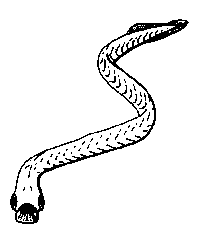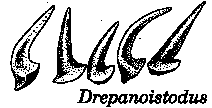
Biology 4402 Lab 3
INTRODUCTION:
Beginning in the mid-19th century, paleontologists began to find
and describe small tooth-like fossils from rocks ranging in age
from the Late Cambrian (about 510 million years ago) to the Late
Triassic (about 210 million years ago). These tooth-like fossils,
named conodonts, had a variety of shapes, including nail-like,
comb-like, fork-like, blade-like, and other shapes. Since conodonts
were never found associated with any other obvious remains of
the animals that bore them, speculation abounded as to what sort
of animal they might have come from. Living animals in a number
of phyla have jaws, teeth, spicules, etc. that are at least superficially
like conodonts. Not until 1983 was the fossil found that clinched
the case. It was a rare worm-like fossil, soft-bodied in life,
with V-shaped segments, some sort of tail fin, a notochord-like
structure. . . and a full set of conodonts in the head region.

Exactly where conodonts fit in the vertebrate family tree is not
certain. They show some typical vertebrate characters (conodonts
are quite similar in microstructure to vertebrate odontodes, and
the animals probably had cartilage capsules around their cephalic
sense organs). However, they also show some cephalochordate-like
characters (they had V-shaped myomeres and no trace of vertebrae).
A few more conodont animals have since been found, but much still
remains to be learned about their anatomy and mode of life. Yet
despite their "primitive" nature, they formed a highly
successful and diverse group of animals, with hundreds of species
distributed worldwide over a 300-million-year period. Conodonts
are abundant in many rock strata from this time frame, in particular
limestones. Fortunately for us, they are common in certain rocks
of the Ozark and Ouachita regions.
We now know that most conodont animals bore a number of conodonts
of several types (conodont assemblages), which were arranged
in a bilaterally symmetrical pattern. In general, conodonts that
are bilaterally symmetrical were located on the animal's midline;
those that are asymmetrical existed in mirror-image forms which
were arranged on opposite sides of the animal's mouth. The posterior
P elements were usually blade-like or plate-like, and in
many cases seem to have fit together like scissor blades. The
more anterior M elements and S elements were often
pick-like, comb-like or fork-like. The last page of this lab handout
shows four such sets of conodonts from four different species
of animal. Notice that for every symmetrical Sa element,
for instance, there should be two Sb, Sc,
etc. elements, one in each "mirror image" form.
PROCEDURE:
1. Your humble professor recently drove to a town called
Allison, Arkansas, a few miles north of Mountain View and east
of Blanchard Springs, and collected samples of limestone from
two rock layers of Ordovician age. The older layer is known as
the Kimmswick Limestone, while the younger layer is called the
Fernvale Limestone.
2. For the past week, crushed samples of these limestones
have been slowly dissolving in 10% acetic acid in the fume hood
in your classroom. Weak acid dissolves the limestone (calcium
carbonate) but not the conodonts inside (calcium phosphate).
3. Your assignment is to pick through the acid-resistant
residue of these limestones. Half the class will examine the Kimmswick
Limestone, and half will study the Fernvale Limestone. Obtain
a dish of rinsed residue from your instructor, and examine it
under a dissecting microscope for the presence of conodonts.
4. When you find a conodont, pick it up with a small paintbrush
and transfer it to a cardboard microfossil slide. The dried adhesive
on the slide will hold the conodont in place. It will help identification
if you try and place similar conodonts on the same row of numbered
squares on your cardboard slide.
TIPS:
The most common fossils you'll probably see will be tiny gastropods (snails). Broken pieces of these snails can resemble simple conodonts, but a little experience will help you pick out the conodonts.
The conodonts will tend to be darker than the other particles in the sediment. Typical conodonts from this site range from black to brown to dark olive green.
Be patient! This lab will take some diligence. If you absolutely
cannot find anything in your acid residue, get another dish.
5. Use the pictures on the last page of this handout to
identify your conodonts as best you can. If you find Aphelognathus
and Amorphognathus, identify which elements in the apparatus
they are. Tally the number of conodonts of each species and the
number of elements of each type. If you can't identify something,
call it "other" and see your instructor.
6. At the end of the lab, we will pool our data. We will use it to answer two questions:
1) Are different conodont species present in the different layers?
2) Are conodont types from the same animal present in
the expected ratios?
Pb Pa M Sc Sb Sa

Pb Pa M Sd Sc Sb Sa



Conodont assemblages that are known from the Fernvale Limestone. For Aphelognathus and Amorphognathus, the conodonts are arranged with the anteriormost S forms on the
left, and the posterior M and P forms on the right.